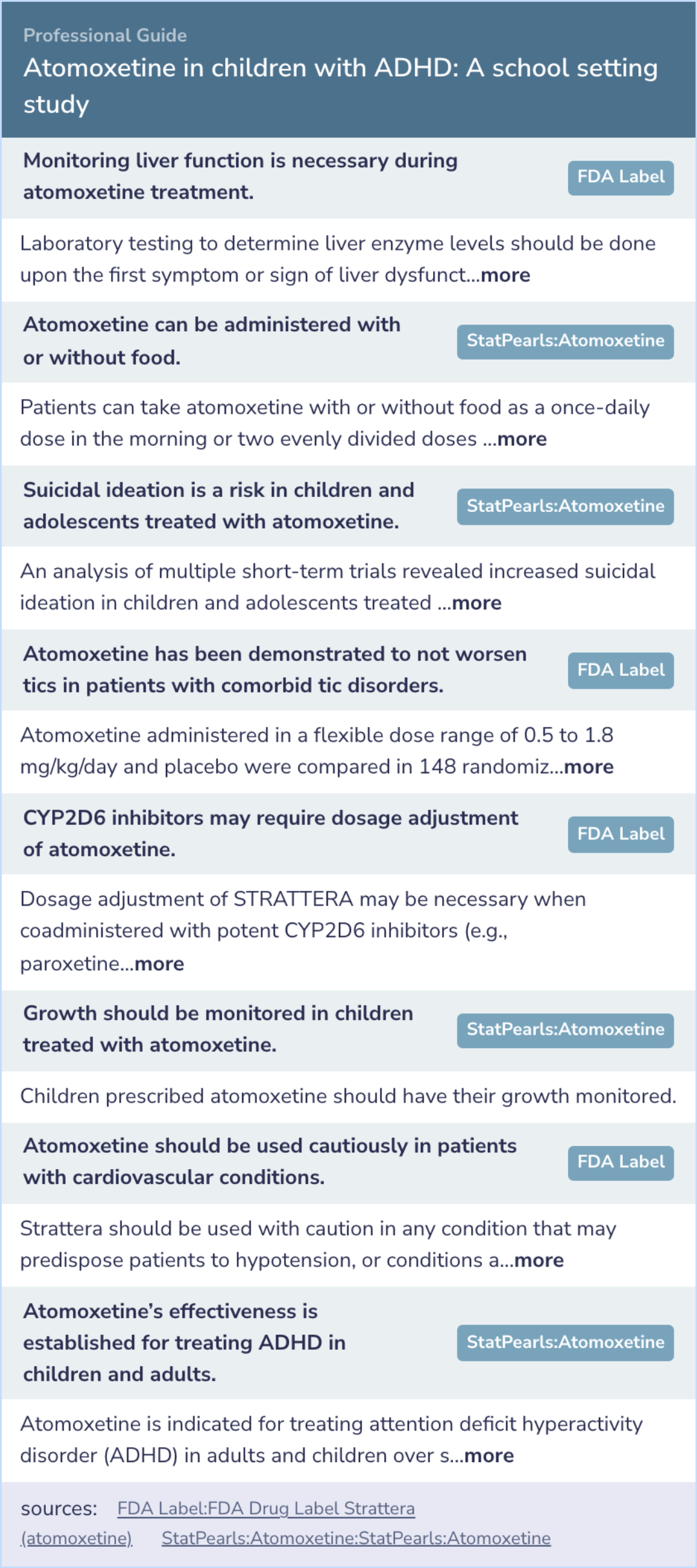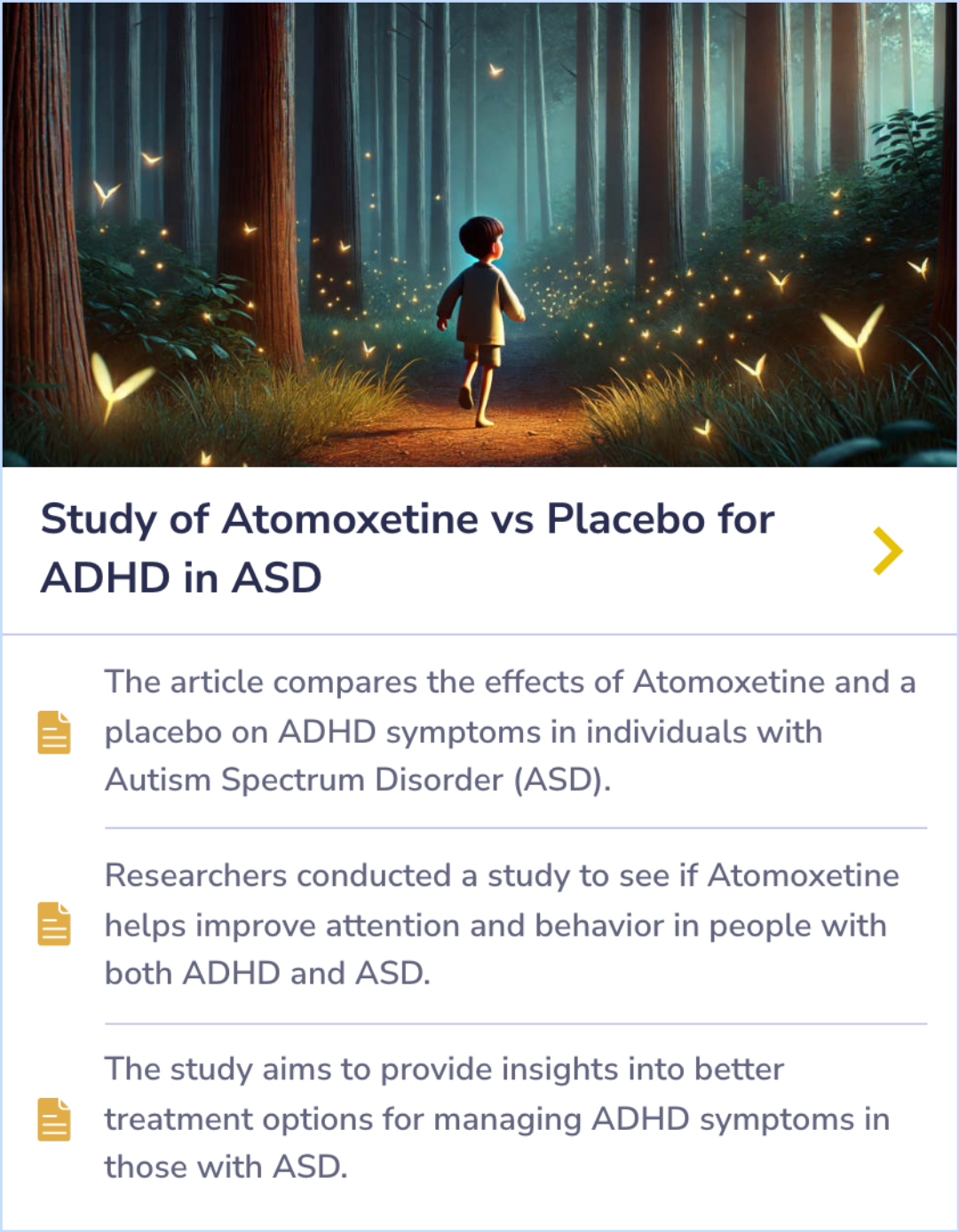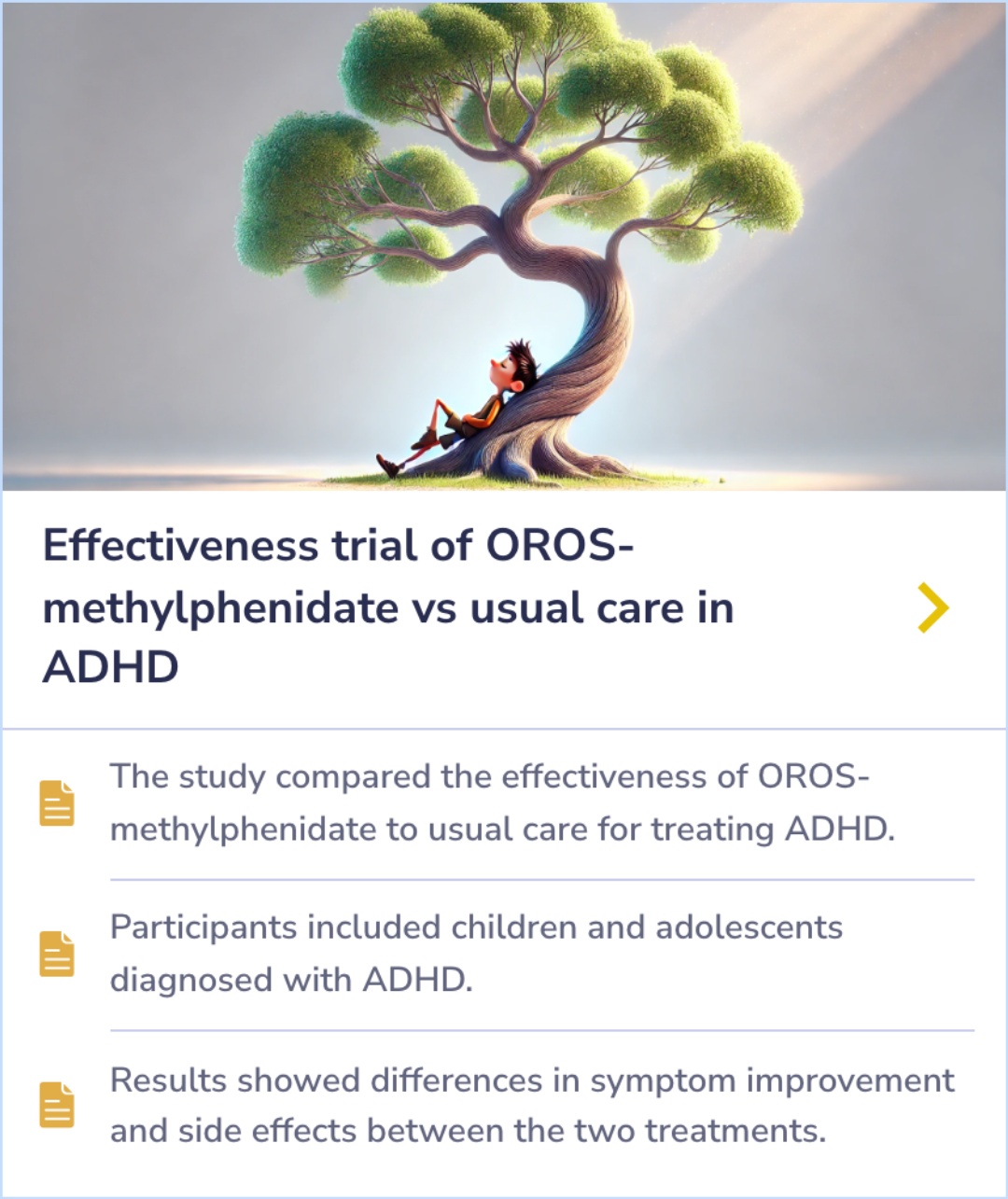Strattera Paper Database
Visual Abstract
A randomized, placebo-controlled study of once-daily atomoxetine in the school setting in children with ADHD
Atomoxetine in children with ADHD: A school setting study
October 25, 2024
author
Weiss M, Tannock R, Kratochvil C, Dunn D, Velez-Borras J, Thomason C, Tamura R, Kelsey D, Stevens L, Allen AJ
journal
J Am Acad Child Adolesc Psychiatry
Date Published
July 2005
Why link to a visual abstract?
What is a visual abstract?
Original
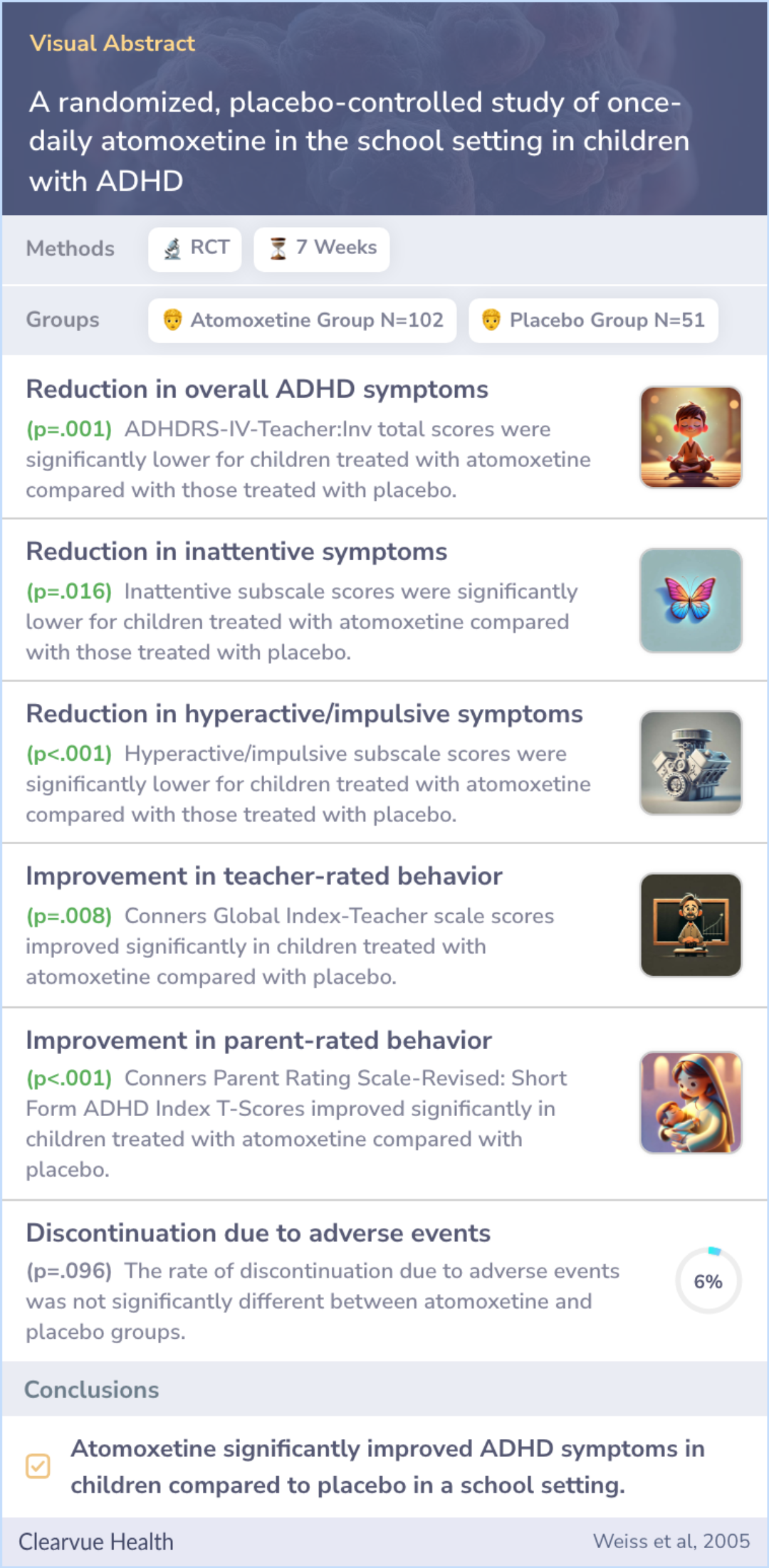
Study Summary
🔬
What They Studied
They studied the effectiveness of atomoxetine compared to placebo in reducing ADHD symptoms in children, using teacher reports.
💡
What They Found
They found that atomoxetine significantly reduced ADHD symptoms in children compared to placebo, as reported by teachers.
📚
What This Means
These findings support the current evidence that atomoxetine (Strattera) effectively reduces ADHD symptoms and aligns with its approved use in ADHD treatment programs.
Study Summary
Study Overview
This study aimed to explore how well atomoxetine, a nonstimulant medication, works for treating ADHD symptoms, particularly from a teacher's perspective. It found that improvements reported by teachers were similar to those noted by parents, highlighting the medication's effectiveness at school.
Moreover, the study suggests that while both teacher and parent reports are valuable, teachers may notice changes in behavior that parents might miss. These insights can help shape future treatments and understanding of ADHD.
Moreover, the study suggests that while both teacher and parent reports are valuable, teachers may notice changes in behavior that parents might miss. These insights can help shape future treatments and understanding of ADHD.
Abstract: background
Five studies have demonstrated the effectiveness of atomoxetine compared with placebo in reducing symptoms of attention-deficit/hyperactivity disorder (ADHD) based on parent reports. The primary objective of this clinical trial was to assess the effi...more

Teacher Reports on Treatment
"This study extends previous results based on parent reports showing that once-daily administration of atomoxetine is safe and effective in improving ADHD symptoms in children and demonstrates that outcomes at school are similar when symptoms are reported by teachers."
Need for Further Research
"Further research is needed to determine the responsiveness to treatment of academic performance, socialization, child perceptions of outcome, and other outcomes beyond the core symptoms of ADHD."
Importance of School Environment
"Because of the importance of school in children's lives, improvement in ADHD symptoms at school is an important requirement for any ADHD therapy."
Study Summary
Methods
The study involved 153 children aged 8-12 years, who were divided into two groups to receive either atomoxetine or a placebo over a period of 7 weeks, with a 2:1 ratio favoring the medication group. The primary tool for assessment was the Attention-Deficit/Hyperactivity Disorder Rating Scale-IV-Teacher Version. Teachers reported observations, which were then evaluated by investigators to track changes in the participants' ADHD symptoms.
Teachers' assessments are crucial as they witness children’s academic and social interactions in a structured environment. This teacher-focused evaluation complements other studies that rely on parent reports, offering a fuller understanding of atomoxetine's real-world implications.
Teachers' assessments are crucial as they witness children’s academic and social interactions in a structured environment. This teacher-focused evaluation complements other studies that rely on parent reports, offering a fuller understanding of atomoxetine's real-world implications.
Abstract: methods
One hundred fifty-three patients aged 8-12 years were randomly assigned to receive once-daily atomoxetine or placebo in a 2:1 ratio for 7 weeks. ADHD symptoms at school were primarily assessed by baseline-to-endpoint change on the Attention-Deficit/H...more

Study Summary
Results
The findings indicated that children receiving atomoxetine showed significant improvements in ADHD symptoms compared to the placebo group. Teachers observed reductions in overall ADHD symptoms, including inattentiveness and hyperactivity/impulsivity, emphasizing the drug's effectiveness even in school settings.
Additionally, other evaluation methods, such as clinician and parental scales, supported these findings. Few children stopped the medication due to side effects, suggesting that atomoxetine is generally well-tolerated. The reported improvements assure that the medication not only impacts home environments but extends its benefits to the school setting.
Additionally, other evaluation methods, such as clinician and parental scales, supported these findings. Few children stopped the medication due to side effects, suggesting that atomoxetine is generally well-tolerated. The reported improvements assure that the medication not only impacts home environments but extends its benefits to the school setting.
Abstract: results
ADHDRS-IV-Teacher:Inv total scores were significantly lower for children treated with atomoxetine compared with those treated with placebo (p = .001). Similar results were observed for the inattentive (p = .016) and hyperactive/impulsive (p < .001) A...more

Study Summary
Conclusions
The research confirms that atomoxetine is a beneficial medication for managing ADHD symptoms in children. The study highlights that teacher reports align with what parents previously noted, emphasizing the effectiveness and safety of the medication across different settings.
This school-focused evidence reinforces the use of atomoxetine for treating ADHD, providing confidence that both home and school environments can see noticeable improvements. It further assures healthcare providers and families about the drug’s efficacy and safety from the teachers' perspectives.
This school-focused evidence reinforces the use of atomoxetine for treating ADHD, providing confidence that both home and school environments can see noticeable improvements. It further assures healthcare providers and families about the drug’s efficacy and safety from the teachers' perspectives.
Abstract: conclusions
This study extends previous results based on parent reports showing that once-daily administration of atomoxetine is safe and effective in improving ADHD symptoms in children and demonstrates that outcomes at school are similar when symptoms are repo...more
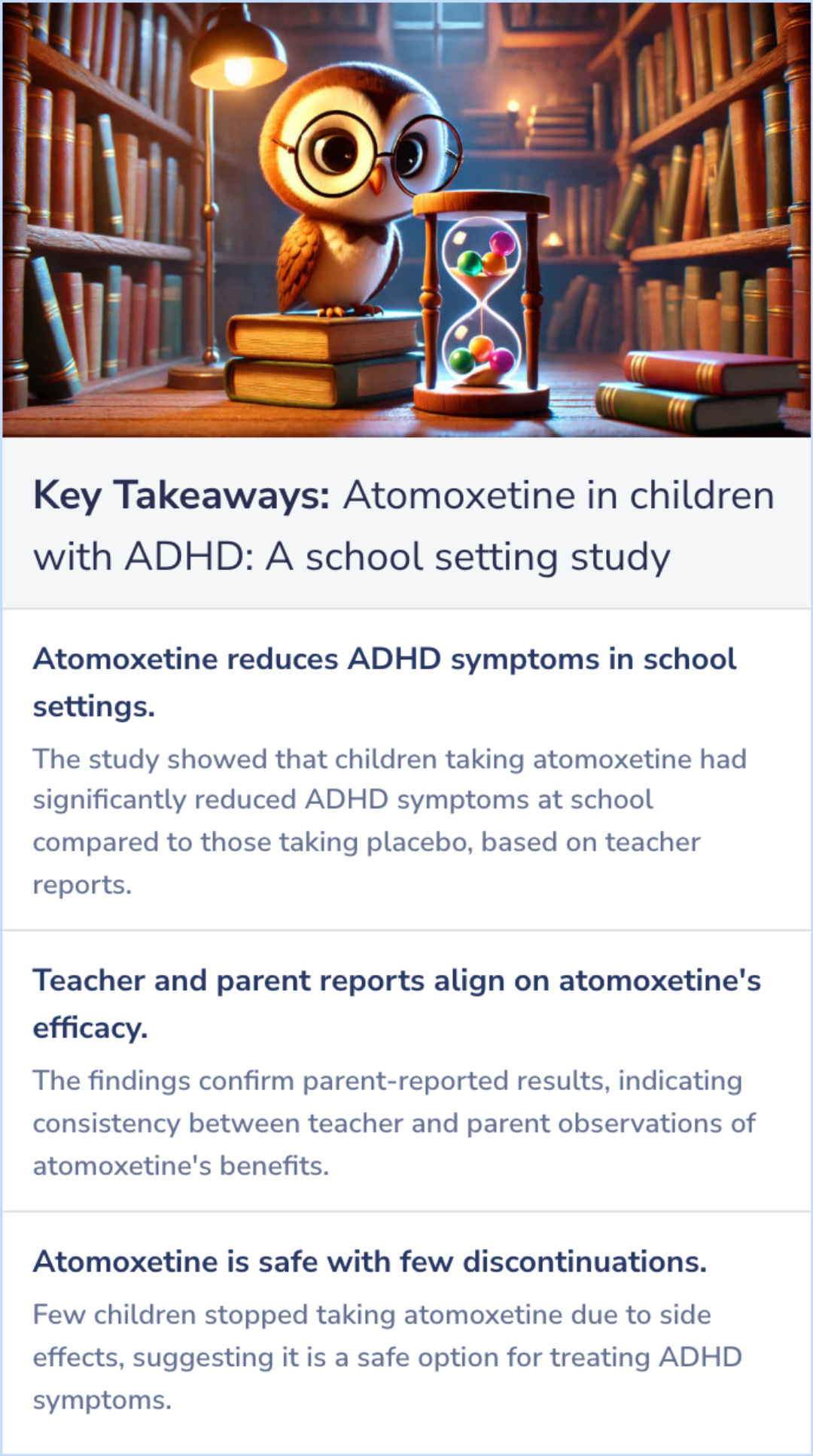
Background Information
Patient Guide
💊
FDA Approval for ADHD
Atomoxetine is FDA-approved to treat ADHD in children over six, alongside adults.
⚙️
Norepinephrine Reuptake Inhibition
Atomoxetine works by selectively inhibiting norepinephrine reuptake, enhancing attention.
🧠
Comprehensive Treatment Program
Including Atomoxetine in a treatment program should involve psychological, educational, and social support.
💊
Dosage and Administration
Atomoxetine can be taken in varying capsule doses and does not require food.
📊
Common Issues and Monitoring
Monitor patients for psychiatric symptoms and growth due to Atomoxetine's adverse effects.
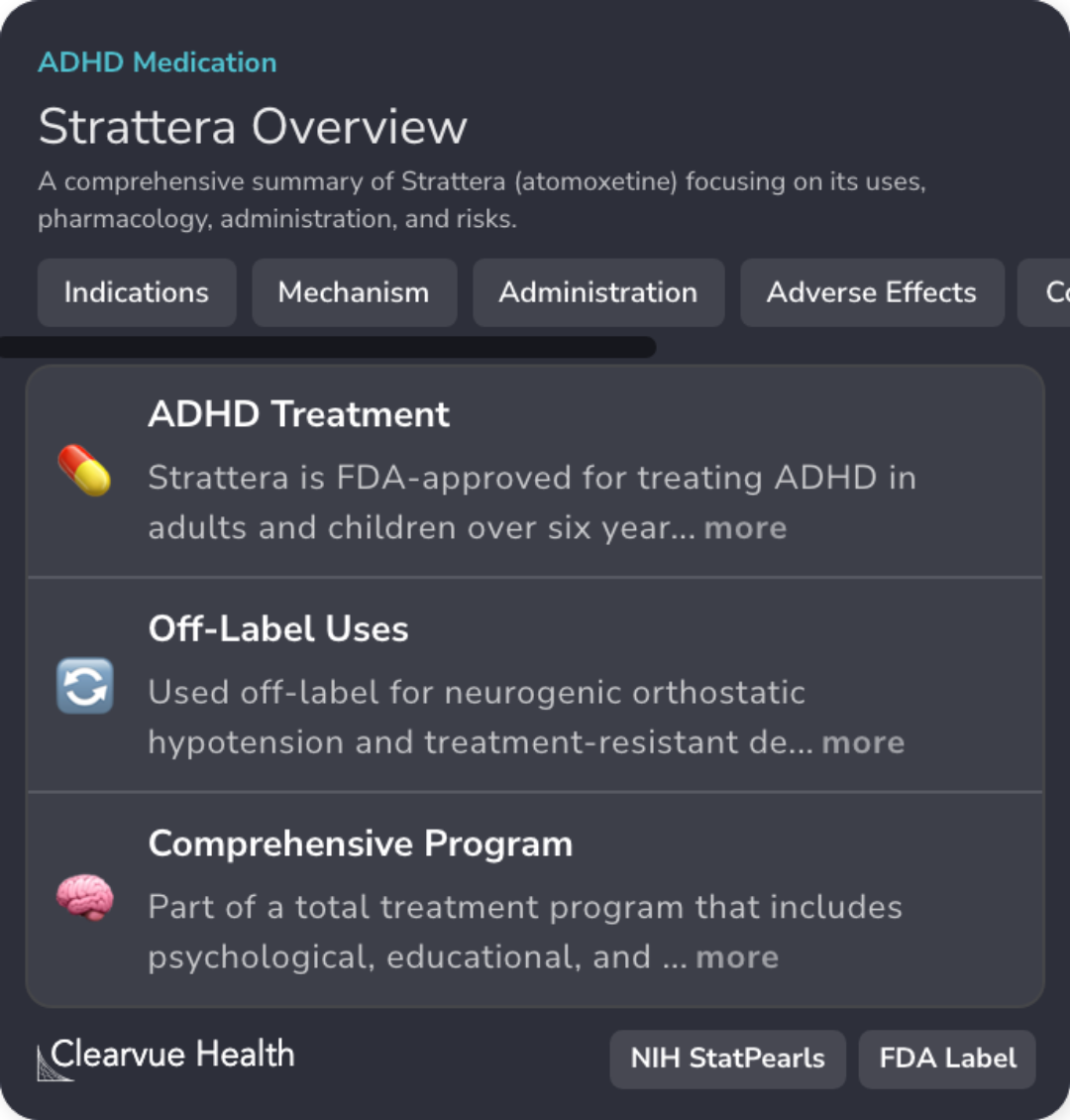
Professional Guide
Expert Opinion: Atomoxetine in children with ADHD: A school setting study
In line with findings that support atomoxetine's efficacy based on teacher reports, healthcare professionals should monitor liver function during treatment.
Treatment can occur with or without food, and dosage adjustment may be needed with CYP2D6 inhibitors.
Suicidal ideation is a noted risk, and atomoxetine does not exacerbate tics in patients with comorbid disorders.
Monitoring growth and cautious administration for patients with cardiovascular conditions are advisable.
Treatment can occur with or without food, and dosage adjustment may be needed with CYP2D6 inhibitors.
Suicidal ideation is a noted risk, and atomoxetine does not exacerbate tics in patients with comorbid disorders.
Monitoring growth and cautious administration for patients with cardiovascular conditions are advisable.
Evidence Summary
Comparing Methylphenidate and Atomoxetine for ADHD
This article explores the roles and differences between methylphenidate and atomoxetine in managing ADHD, analyzing which may offer more benefits for individuals dealing with the condition. Both medications target ADHD symptoms, yet their effectiveness and application vary. This examination highlights the nuanced choices available to those seeking treatment.
Results suggest atomoxetine's efficacy as evident from teacher reports, emphasizing diverse perspectives in assessing these treatments.
Results suggest atomoxetine's efficacy as evident from teacher reports, emphasizing diverse perspectives in assessing these treatments.
Evidence Summary
Atomoxetine vs Placebo: ADHD Treatment in ASD
A study highlights the comparison of Atomoxetine and placebo in children with ADHD symptoms who also have Autism Spectrum Disorder (ASD). Researchers explore whether Atomoxetine positively influences attention and behavior in these children, aiming to develop better treatment strategies.
Insights into managing ADHD within ASD are drawn from examining how Atomoxetine might enhance attention and behavior, providing a comparative view with a placebo.
Insights into managing ADHD within ASD are drawn from examining how Atomoxetine might enhance attention and behavior, providing a comparative view with a placebo.
Evidence Summary
Comparing ADHD Treatments: Symptom and Side Effect Insights
The study compared two treatment methods for ADHD: OROS-methylphenidate and usual care. It evaluated which approach led to better symptom improvement and examined differences in side effects. Children and adolescents with ADHD were the focus of this research.
Results highlighted variations in how well symptoms improved and what side effects occurred between the two treatments, offering insights into their relative effectiveness.
Results highlighted variations in how well symptoms improved and what side effects occurred between the two treatments, offering insights into their relative effectiveness.
